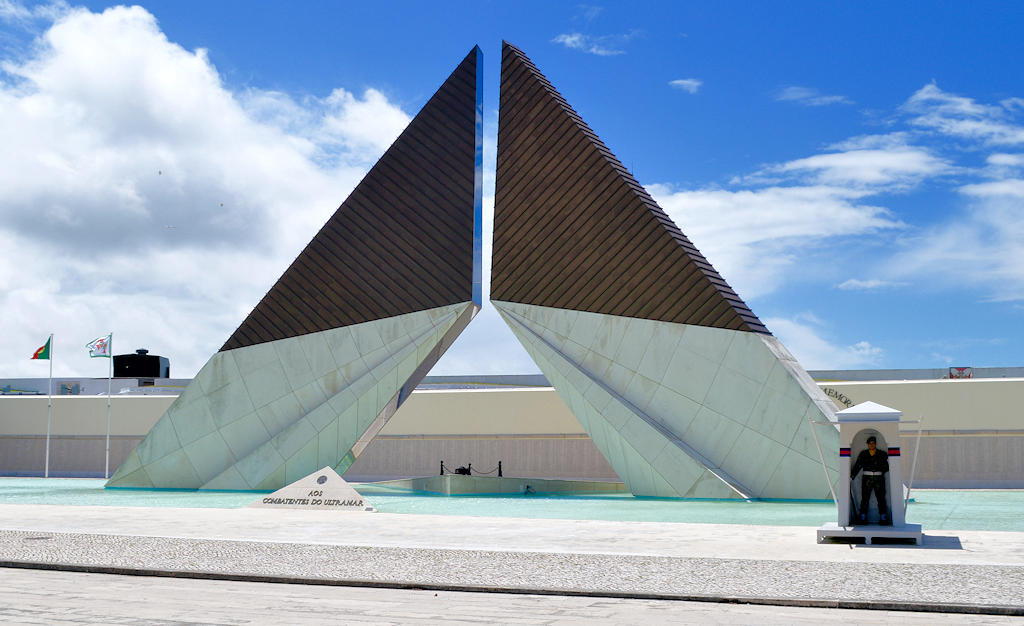Situated in close proximity to the Fort of Bom Sucesso at Jardim de Belém in the Belém municipality of Lisbon, the monument forms part of a colonial historical complex alongside other structures and memorials associated with Portuguese colonialism, such as the The Discoveries Monument (Padrão dos Descobrimentos), the Belém Tower (Torre de Belém), and the Praça do Império.
The monument itself is a completely abstract design and consists of several elements. In the center of a rectangular square, there are two large pillars converging at a 45-degree angle to form a triangle or a portico. The pillars are made of stone at the bottom and metal at the top. The downward-facing sides of the pillars are mirrored. In the center of the triangle, below the pillars, there is a small metal basin with a lit flame known as the "Flame of the Motherland" (Chama da Pátria). In front of the water basin, there is a plaque with the inscription "aos combatentes do Ultramar" (to the overseas combatants) in capital letters. Behind the triangle of pillars, there is a long wall enclosing the monument, adorned with around 11,000 names of the fallen soldiers of the colonial war.
According to the sculptor Francisco José Ferreira Guedes de Carvalho, the flame symbolizes the warmth and security of the motherland. The water basin represents the spatial separation between the metropolis and the overseas territories, while the converging pillars symbolize the unity of Portugal. The monument is guarded by two soldiers who patrol the area as a mark of respect for the fallen.
The idea for the monument originated from two veterans' associations in 1985, more than ten years after the end of the Portuguese Colonial War. They formed a small commission, the National Commission for the Construction of a Monument in Memory of the Dead in the Overseas War (Comissão Nacional Pró-Monumento em Memória dos Mortos no Esforço da Guerra Ultramarina), with the aim of creating a memorial to honor the over 8,000 Portuguese soldiers who lost their lives in the war.
On July 9, 1987, the associations formed an executive commission tasked with executing and coordinating all necessary activities. The commission was led by the veterans' association, with General Altino Magalhães as its president. The commission also included the participation of the Geographical Society of Lisbon (Sociedade de Geografia de Lisboa), the Historical Society of the Independence of Portugal (Sociedade História da Independência de Portugal), the Portuguese Air Force Association (Associação da Força Aérea Portuguesa), the Portuguese Air Force Specialists Association (Associação dos Especialistas da Força Aérea Portuguesa), and the Association of Disabled Veterans of the Portuguese Army (Associação dos Deficientes das Forças Armadas).
Lisbon.vip Recommends
After a public competition, the commission selected sculptor João Antero de Almeida as the responsible artist. Architects Francisco José Ferreira Guedes de Carvalho, Helena Albuquerque, and Sidónio Costa Cabral supported Antero de Almeida in the execution of the design. The foundation stone was laid on May 12, 1993. After eight months of construction, the monument was inaugurated on January 15, 1994.
The Overseas Combatants Monument is widely regarded as a place of remembrance for the Portuguese Colonial War. Military and veterans' associations regularly utilize the site to honor the fallen soldiers or make political statements. Some associations highlight that numerous bodies of Portuguese soldiers have not been located or returned to Portugal.
The Overseas Combatants Monument, with its symbolism, strongly resonates as a site of remembrance for the Portuguese Colonial War. It serves as a focal point for ongoing discussions about the war's legacy, the recognition of the soldiers' sacrifices, and the broader implications of Portugal's colonial history.
Map View



